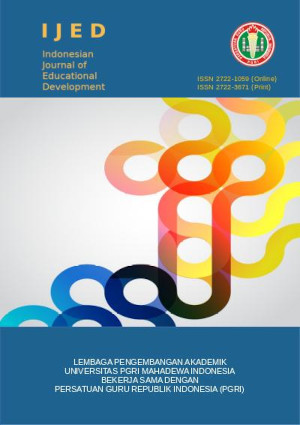DEVELOPMENT OF INSTRUMENT FOR UNDERSTANDING THE CONCEPT OF WRITING SCIENTIFIC ARTICLES FOR LECTURERS USING THE ADDIE MODEL: EMPIRICAL VALIDITY AND RELIABILITY
DOI:
https://doi.org/10.59672/ijed.v5i4.4324Keywords:
ADDIE, conceptual understanding instrument, scientific article writing, validity, reliabilityAbstract
This study aims to develop an instrument to assess lecturers' conceptual understanding of scientific article writing using the ADDIE model (Analyze, Design, Develop, Implement, Evaluate). The instrument is designed to evaluate lecturers' comprehension of key aspects of scientific writing, including structure, methodology, publication ethics, and the use of academic language. Adopting a research and development approach, the study involved expert validation and empirical testing with 275 respondents from various regions across Indonesia. The findings indicate that the instrument exhibits high content validity, with an average Scale Content Validity Index (S-CVI/Ave) of 0.968, and robust internal reliability, as evidenced by a Cronbach’s Alpha of 0.852. Item-total correlation analysis confirmed the validity of all items, with Corrected Item-Total Correlation values exceeding 0.3044. The instrument functions both as an evaluative tool for assessing lecturers' scientific writing skills and as a learning resource to enhance their competencies. The study concludes that the instrument is a valid and reliable measure of lecturers' conceptual understanding of scientific article writing. Its implications highlight its potential as a vital resource in training and professional development programs for lecturers in higher education institutions.
Downloads
References
Anderson, L. W., & Krathwohl, D. R. (2001). A Taxonomy for learning, teaching, and assessing. Pearson.
Arsyad, S., & Adila, D. (2018). Using local style when writing in English: The citing behaviour of Indonesian authors in English research article introductions. Asian Englishes, 20(2), 170–185. https://doi.org/10.1080/13488678.2017.1327835
Azwar, S. (2010). Reliabilitas dan validitas dalam penelitian pendidikan. Pustaka Pelajar.
Branch, R. M. (2009). Instructional design: The ADDIE approach. Springer.
Budhyani, I. D. A. M., & Angendari, M. D. (2021). Kesulitan dalam menulis karya ilmiah. Mimbar Ilmu, 26(3), 400–407. https://doi.org/10.23887/mi.v26i3.40678
Budiwan, J., & Suswandari, M. (2020). Pelatihan menulis artikel ilmiah jurnal terakreditasi Sinta dan terindeks Scopus dalam mengembangkan kompetensi profesional dosen. Jurnal Pengabdian pada Masyarakat. https://doi.org/10.32585/educate.v1i1.1797
Brown, T. (2014). The development of measurement tools: Steps, validation, and reliability testing. SAGE Publications.
Candiasa, I. M. (2010). Pengujian instrumen penelitian disertai aplikasi ITEMAN dan BIGSTEPS. Undiksha Press.
Day, R. A., & Gastel, B. (2006). How to write and publish a scientific paper (6th ed.). Cambridge University Press.
Direktorat Jenderal Pendidikan Tinggi, Riset, dan Teknologi (Diktiristek). (2024). Pedoman akreditasi jurnal ilmiah. Dikti.
Direktorat Riset, Teknologi, dan Pengabdian kepada Masyarakat (DRTPM). (2024). Panduan pelatihan penulisan artikel ilmiah tahun 2024. DRTPM.
Fajaruddin, S., Retnawati, H., Wijaya, T., Ramadhan, S., & Prihatni, Y. (2021). Alhamdulillah, butir pengembangan instrumen penilaian artikel jurnal ilmiah dikatakan valid oleh para rater. Measurement In Educational Research, 1(2), 89-96. http://dx.doi.org/10.33292/meter.v1i2.156
Flower, L., & Hayes, J. R. (1981). A cognitive process theory of writing. College composition and communication, 32(4), 365–387. https://doi.org/10.2307/356600
Kolb, D. A. (1984). Experiential learning: Experience as the source of learning and development. Pearson Education Inc.
Koyan, I. W. (2011). Assesment dalam pendidikan. Universitas Pendidikan Ganesha.
Lawshe, C. H. (1975). A quantitative approach to content validity. Personnel Psychology, 28(4), 563–575. https://doi.org/10.1111/J.1744-6570.1975.TB01393.X
Lubis, M. S., Rahimah, A., & Lubis, I. S. (2019). Kesulitan-Kesulitan yang dihadapi oleh mahasiswa yang mengampuh mata kuliah Bahasa Indonesia di Program Studi Bahasa Indonesia IPTS dalam penulisan karya tulis ilmiah (KTI). Jurnal Education And Development, 7(3), 193-199.
Messick, S. (1989). Validity. In R. L. Linn (Ed.), Educational measurement (3rd ed., pp. 13-103). American Council on Education/Macmillan
Nandiyanto, A. B. D., Hamidah, I., Haristiani, N., Muktiarni, M., & Rahayu, N. I. (2024). Pelatihan penulisan artikel ilmiah hasil riset. Jurnal Abdimas Kartika Wijayakusuma, 5(2), 509–510. https://doi.org/10.26874/jakw.v5i2.536
Nunnally, J. C., & Bernstein, I. H. (1994). Psychometric theory. McGraw-Hill
Brown, P., & Brown, C. (2014). Transformative Learning Theory in Gerontology: Non-Traditional Students. Educational Gerontology, 40(5), 321-345
Peraturan Menteri Pendidikan, Kebudayaan, Riset, dan Teknologi Nomor 39 Tahun 2021 tentang Integritas Akademik.
Rakhman, F., Surur, M., & Darmawati, L. E. S. (2020). Peningkatan produktivitas publikasi melalui pelatihan penulisan artikel ilmiah bagi dosen STIQ Wali Songo Situbondo. Journal of Educational Development and Innovation
Riduwan. (2018). Dasar-Dasar Statistika. Alfabeta.
Sekaran, U., & Bougie, R. (2016). Research methods for business: A skill-building approach (7th ed.). John Wiley & Sons.
Sugiyono. (2005). Metode penelitian kuantitatif, kualitatif, dan R&D. Alfabeta.
Sugiyono. (2017). Penelitian dan pengembangan: Teori dan implementasi. Alfabeta.
Swales, J. M. (1990). Genre analysis: English in academic and research settings. Cambridge University Press.
Swales, J. M., & Feak, C. B. (2012). Academic writing for graduate students: Essential tasks and skills (3rd ed.). University of Michigan Press.
Udil, P. A. (2021). Pelatihan penulisan artikel ilmiah penelitian tindakan kelas untuk publikasi pada jurnal iIlmiah. Jurnal Nasional Pengabdian Masyarakat, 2(1), 21-27. https://doi.org/10.47747/pengabdiankepadamasyarakat.v2i1.257
Undang-Undang Republik Indonesia Nomor 12 Tahun 2012 tentang Pendidikan Tinggi.
Wardoyo, C., Nuris, D. M., & Fauzan, S. (2022). Pelatihan penyusunan artikel ilmiah bagi guru-guru akuntansi se-Kabupaten Malang. Jurnal Pendidikan dan Keilmuan. https://doi.org/10.37729/abdimas.v6i1.1542
Widana, I. W. & Ratnaya, I. G. (2021). Relationship between divergent thinking and digital literacy on teacher ability to develop HOTS assessment. Journal of Educational Research and Evaluation, 5(4), 516-524. https://doi.org/10.23887/jere.v5i4.35128
Yasa, I. P. G., Widana, I. W., & Aisyah, S. (2023). The determination of the principal’s leadership style, teachers’ work motivation, and mind-set of the performance of elementary school teachers. Edukasi: Jurnal Pendidikan dan Pengajaran, 10(1), 42-50. https://doi.org/https://doi.org/10.19109/ejpp.v10i1.16790
Yusuf, M., Pahala, I., Ulupui, I. G. K. A., Muliasari, I., Hasanah, N., Jaya R, T. E., Sasmi, A. A., & Zairin, G. (2022). Training basic skills of scientific writing and publication to improve research competence. Jurnal Pemberdayaan Masyarakat Madani, 6(2), 375–382. https://doi.org/10.21009/jpmm.006.2.12
Zaden, H., & Meedya, S. (2024). Writing for publication: Argument and evidence. Women and Birth. https://doi.org/10.1016/j.wombi.2024.101595
Downloads
Published
How to Cite
Issue
Section
License
Copyright (c) 2025 Yoga Dwi Arianda, Luthfi Ilham Ramdhani, Awaluddin Tjalla, Lussy Dwi Utami Wahyudi

This work is licensed under a Creative Commons Attribution 4.0 International License.
This is an Open Access article distributed under the terms of Creative Commons Attribution 4.0 International License, which permits use, sharing, adaptation, distribution and reproduction in any medium or format, as long as you give appropriate credit to the original author(s) and the source, provide a link to the Creative Commons licence, and indicate if changes were made. The images or other third party material in this article are included in the article's Creative Commons licence, unless indicated otherwise in a credit line to the material.

















